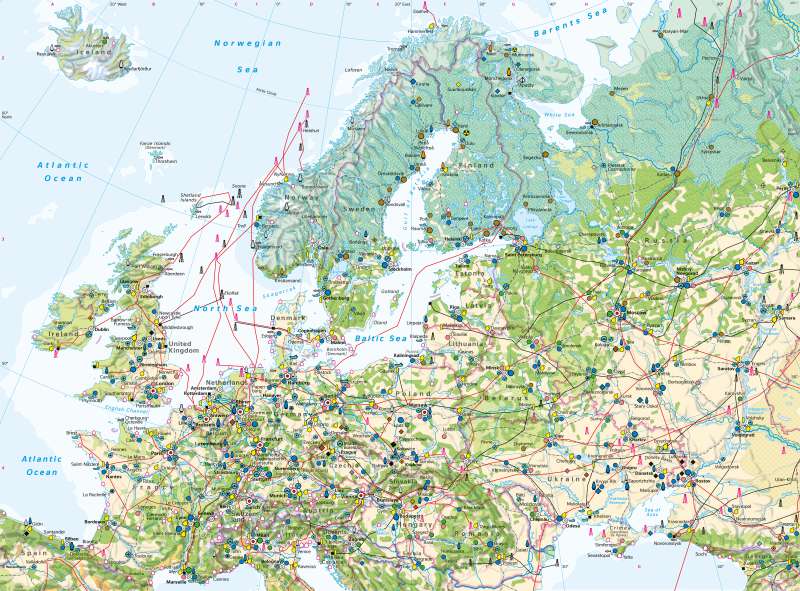Northern Europe - Economy and land use
Economy and land use
978-3-14-100890-6 | Page 80 | Ill. 1

Overview
The map provides an overview of the most important landscape types, mineral resources, industrial and service locations, as well as the oil and gas pipelines in northern Europe. The location structure of industry and services is characterised by:
- a centre-periphery gradient,
- a main axis that runs, with interruptions, from central England via London, the Benelux countries, the Lower Rhine, the Ruhr, the Rhine-Main and Rhine-Neckar regions Neckar region to the Basel/Zurich region,
- metropolitan areas (e.g. Paris, Munich, Moscow) - agglomerations with a traditionally strong industrial and/or service orientation (e.g. Halle-Leipzig, Upper Silesia).
Raw materials and mining
Europe has a wide range of mineral resources. In northern Europe, iron ores and various non-ferrous metal deposits are particularly abundant. Oil fields of greater importance are found in Russia and in the North Sea. In addition to its use as an energy source, crude oil is also used as an important raw material for the chemical industry. A pipeline network connects the production areas with the locations of the refineries and the chemical industry, which are preferably located on coastal sites or inland with good transport connections. Of the coal mining sites shown on the map, only a few are still competitive in international comparison, even though they once formed the basis for the emergence of entire industrial districts, and some are still producing coal today. In many places these sites represent a retreat stage. Hard coal as an export commodity only plays a certain role for Poland. Lignite production in Germany, Poland and the Czech Republic is mainly used for on-site electricity generation. Norway, Sweden and Finland have numerous locations for the wood processing industry and the paper and cellulose industry because of their forest wealth.
Old industrial areas
The starting point and basis of industrialisation in Western and Central Europe was the coal and steel industry. Its economic and regional political significance has had a serious impact in most of the old industrial areas. The structural change took place with harsh cutbacks or buffered by subsidies and regional support. Today, the iron and steel industry has two spatial focal points. In the inland, there are locations in the old coalfields that have successfully reoriented themselves through rationalisation, process and product innovations and international networking (e.g. in the Ruhr, Wales, Salzgitter, Lorraine). The younger locations are on the coasts. They benefit from the favourable transport conditions there, as imported raw materials can be obtained directly by sea.
Growing industries
Growing industries prefer centrally located regions with agglomeration advantages (e.g. education and research, innovation potential, a wide range of services, a skilled workforce, optimal transport links). High-tech industries such as aircraft and spacecraft manufacturing and the electrical industry have their most important locations in conurbations such as Munich and in diversified industrial areas with highly qualified entrepreneurs and skilled workers and with a long tradition (e.g. Baden-Württemberg). Locations of multinational corporations shape entire regions (e.g. Wolfsburg). Aircraft construction is a special feature. The locations of the Airbus Group were distributed among the participating states.
Services
A differentiated network of specialised service locations has developed within Europe. There are differences in the industry structure between the large agglomerations on the one hand and the peripheral areas on the other. London, Frankfurt/Main, Brussels, and Rotterdam are examples of important service locations in the agglomerations. While Brussels is dominated by media and administration, Frankfurt/Main and London are transport and financial locations. Rotterdam as a port location specialises in logistics. Tourism dominates in some of the peripheral regions, for example on the Danish coasts and in the Alps.
Growing industries
Growing industries prefer centrally located regions with agglomeration advantages (e.g. education and research, innovation potential, a wide range of services, a skilled workforce, optimal transport links). High-tech industries such as aircraft and spacecraft manufacturing and the electrical industry have their most important locations in conurbations such as Munich and in diversified industrial areas with highly qualified entrepreneurs and skilled workers and with a long tradition (e.g. Baden-Württemberg). Locations of multinational corporations shape entire regions (e.g. Wolfsburg). Aircraft construction is a special feature. The locations of the Airbus Group were distributed among the participating states.




